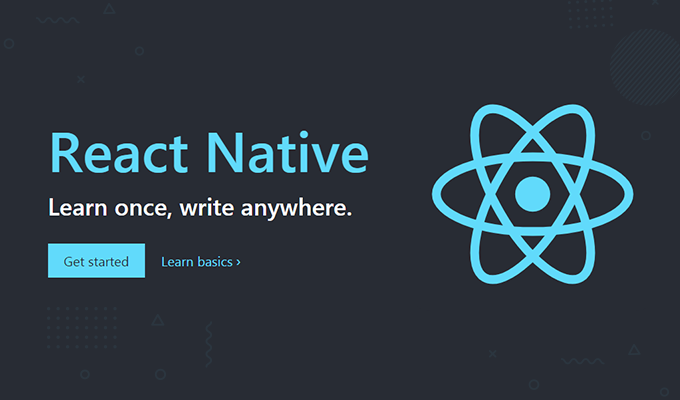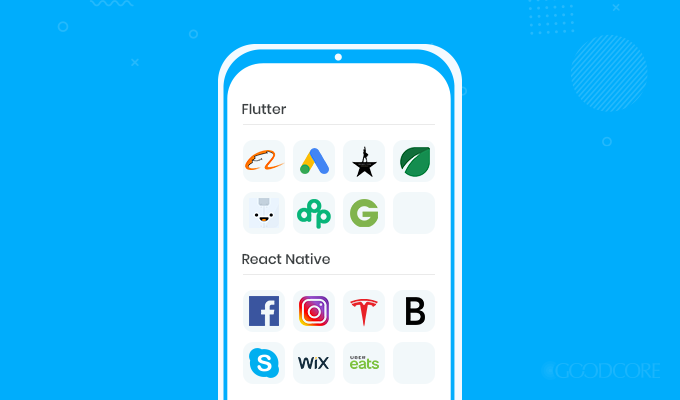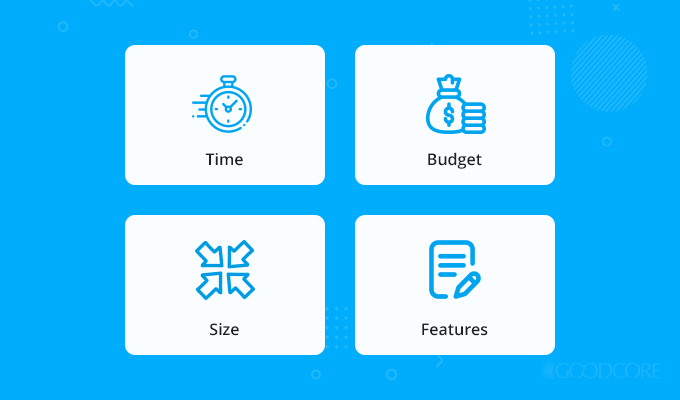Every business, whether large- or small-scale, is now looking for new ways to reach its customers. For that reason, the development of mobile apps is constantly on the rise. Customers also love and prefer apps because they bring their favourite brands closer – just a tap away! It is important for businesses to take care of this need by getting their very own mobile apps.
While native app development for the Android and iOS platforms is common, Flutter vs React Native is what everyone seems to be talking about these days. Let’s take a look at the latest entries in the world of mobile software development and help you decide which one to choose, Flutter or React Native!

We have a few great topics on the agenda today. Let us walk you through them.
- What is Flutter framework?
- What is React Native framework?
- The good and bad sides of React Native vs Flutter framework
- A detailed comparison of Flutter vs React Native
Let’s get started!
What is Flutter?
Flutter is a UI toolkit that greatly facilitates the process of mobile application development. It is a front end technology which allows you to develop beautiful user interfaces for your apps.
The Flutter framework project came into being in 2014 but, like most new technologies, it did not rise to popularity immediately. Originally, it was known as “Sky”. Flutter was first introduced to developers in 2017. The highlight of Flutter’s journey occurred towards the end of 2018 when version 1.0 was released as the first-ever production-ready version.
It was originally invented and owned by Google but is now an open-source project. Developers all over the world now contribute to it.
Flutter holds special status because it allows developers to make apps for multiple platforms using the same codebase. That means you can code an app once and run it on an Android as well as iOS phone. This makes Flutter an excellent choice for cross-platform app development. The web compatible version is also available now, although it is not very stable at the moment.
What is React Native?
React Native is another technology that has now become quite popular in the world of mobile app development. Like Flutter, React Native is also a cross-platform app development framework.

React Native is owned by Facebook. It was preceded by React.js, known as FaxJS at the time. It was first developed and implemented in Facebook’s own web app in 2011. In 2013, React language was made open-source, and two years later, the first release of React Native was launched and made public in 2015.
Since React Native was released way ahead of Flutter, it has had a lot more time to become relatively stable and mature. The community is also quite expansive. Facebook, along with the developer community, has been consistently working to improve React Native.
The difference between React and React Native
React language is a front end technology for web applications, while React Native was built exclusively for mobile app development. Also, React is a library with a set of pre-written functions meant to help coders. React Native, on the other hand, is a framework that is based on React. However, it would not be wrong to say that React Native is based on React.
Flutter vs React Native – A Detailed Comparison
It is now time to get to the main part of our discussion: the side-by-side comparison of Flutter vs React Native.
There are several aspects of both frameworks that we are going to consider when comparing the two, such as:
- React Native vs Flutter programming languages
- Their community support and how it has affected their growth and stability
- The architectural differences
- The process and ease of installation and configuration
Let’s get right into it!
1. Programming Language
Choosing an appropriate programming language is a very crucial part of app development. You need to pick a language that you feel comfortable working with. Ample community support should also be available for the language of your choice since there is always a possibility of you getting stuck in a problem that you just can’t find a solution to.
So let’s compare React Native vs Flutter’s languages.
Coding Language for Flutter
Flutter is based on a new programming language called Dart, which is also an invention of Google’s. Flutter’s dart is object-oriented. Hence, it is easy to pick up for those already familiar with Java or other OOP languages. However, it is still a new and slowly growing language with a long way to go before it can be perfected.
React Coding Language
Since React serves as a foundation for the invention of React Native, they also share a common programming language. React’s coding language is JavaScript. Naturally, React Native follows the same pattern and is based on JavaScript too. JavaScript has been around for many years and is very well-known and popular in the developer community.
2. Stability
When it comes to new technologies, it is very important that you are able to rely and depend on them. The same goes for both React Native and Flutter. They are both quite young compared to the older mobile app development frameworks, but stability is important for both.
Flutter
Flutter was released not very long ago. Therefore, it is still gradually developing. While both the owner and the community are constantly working to improve it, unexpected crashes and bugs may pop up now and then. However, since the release of version 2, the framework has become quite reliable.
React Native
In contrast, React Native has been around for much longer than Flutter has. Therefore, it has had time to grow and mature. Facebook and the rest of the developer community have helped stabilise it to a great extent. Hence, it wins this round of the Flutter vs React Native competition.
3. Architecture
One of the most basic differences between two individual technologies is the way that they are built to function. The same applies to Flutter and React Native as well.
Flutter
Like Flutter Dart, the ownership of Skia (the official framework for Flutter development) also falls under the Google umbrella. It is a rendering engine written in C++. A third party library that is slowly rising to popularity is flutter_flux. BLoC (Business Logic Component) is another viable option.
React Native
The official framework for React Native is Flux. However, the alternative, Redux, is more popular within the React Native community and has rapidly risen to the top over the last few years. Both are quite similar in that they work with stateless components.
4. Installation & Configuration
Every new tool, language, platform, and technology needs to be set up properly before you can start using it. For your ease, we will now go over the installation processes for Flutter vs React Native.
Flutter
There is no shortcut or one-line command for downloading and installing Flutter from the CLI. Once you have downloaded the binary file from GitHub, you also need to modify the PATH variable. After you are done with that, you can then consult the official documentation for further instructions on how to set up an IDE for coding and get started with your very first Flutter project.
React Native
If you are familiar with npm (Node Package Manager) scripts, you will find it very easy to run a few commands on your terminal in order to install React Native. When it comes to starting with your first project, things might get a little tricky. The official documentation for React Native assumes that the reader is already familiar with the initial setup.
For Windows, install Node.js and npm will be installed with it. Next, install React Native CLI by running the following command:
npm install -g react-native-cli
For MacOS, install Node and Watchman using Homebrew. Once you have installed Homebrew, run the following command:
brew install yarn brew install node brew install watchman
Install React Native CLI using the same command:
npm install -g react-native-cli
If you are not familiar with these steps, you might have to watch a tutorial or two on your own, or refer to the official React Native documentation.
5. User Interface
In order to come up with an app that looks and feels truly native, you need to make sure that the framework you use enables you to imitate a native app. The user interface (UI) needs access to native components. For that, Flutter and React Native both use various APIs, components and widgets.
Flutter
One of the best things about Flutter is its wide array of APIs, rendering, navigation and testing components, and libraries. In fact, everything is a widget in Flutter. It gives you everything you need, so you don’t have to look elsewhere.
React Native
Compared to that, React Native does not boast as extensive a collection. Even for accessing the device’s native components, you need third-party APIs. Therefore, when working on React Native, you would have to rely on a lot of third-party libraries during your development process.
6. Automation
The processes of building and releasing newer versions of your application can get quite complicated. Conducting them manually may cause errors or unnecessary delays. Therefore, it is important to find the appropriate tools for automating them.
Flutter
Streamlining the build and release of Flutter apps is possible, but the official documentation outlines a manual process using CLI tools. For automated deployment, however, the documentation recommends a tool called fastlane, which is compatible with Flutter.
React Native
As is the case with its integration support, React Native does not say anything about automation tools in its documentation. Neither does it have any relevant CLI tools available for this task. Third-party tools such as fastlane, however, are available for this purpose.
7. Support for Continuous Integration (CI)
The CI/CD pipeline is an important part of the development process.
CI (Continuous Integration) involves integrating every new change to the application right away and making sure that it does not cause the application to break. CD (Continuous Delivery) refers to the immediate delivery of the application to the user once CI is completed. This process can also be automated so that you can consistently deploy new releases.
When it comes to comparing Flutter vs React Native, there is a vast difference between their continuous integration supports.
Flutter
Flutter’s documentation clearly mentions and explains the CI/CD options. They are very easy to set up using CLI commands.
React Native
React Native’s official documentation has no mention of or instructions on CI/CD setup. There are, however, several guides available online on how to go about it.
8. Customer Base
There are so many cross-platform applications out there – from apps like Uber to writing apps like Grammarly – and a number of cross-platform frameworks but Flutter and React are considered amongst the top ones. The size of the customer base is a significant factor when comparing the success of Flutter vs React Native, not because it proves one framework being better over the other, but because it will help you to understand how much both frameworks have grown over time.
Flutter
One of the first implementations of Flutter development was an app for the famous musical, Hamilton (launched in 2017). Recently, the customer base of Flutter has expanded greatly.
React Native
React Native has been in the field for a very long time. Therefore, it has many accolades to its name in the form of popular users.
| Flutter | React Native |
| AlibabaGoogle Ads
Hamilton Musical Google Greentea Reflectly Apptree Groupon |
FacebookInstagram
Tesla Skype Bloomberg Wix.com UberEats |

9. Documentation
The documentation of any piece of technology is an important learning element. It explains in detail everything you need to know about it. For example, it will tell you how to download, install, and/or set up the new technology that you have decided to work on.
Furthermore, whenever you are stuck – with however major or trivial a problem – you should be able to refer to the documentation and find a solution. Therefore, it is important to consider the quality of the documentation when choosing a new framework for app development.
Flutter
The documentation for Flutter is rated much better in the developer community. It is written in a very easily understandable manner. Since it is very well-organised, it is also highly readable. It is also regularly updated in case of any changes. You should expect a lot of technical details as you dig deeper into it.
React Native
React Native’s documentation is also very extensive. While it stays up-to-date and is very thorough, it may seem quite complex to someone who does not have a lot of experience with coding. Instead of spending too much time on the basics, it dives right into the technicalities.
Flutter vs React Native: What Is Common between the Two?
We have now thoroughly answered the questions, “What is React Native?” and “What is Flutter framework?” and discussed all their features in detail. While there may be a lot of differences between React Native vs Flutter, they also share a few common characteristics.
Here are a few features that are common to both:
- They are both technologies that enable cross-platform app development.
- Both technologies are owned by tech giants, namely Google and Facebook.
- They are open-source and free for all to use.
- Both React Native and Flutter development support hot-reloading.
- They are excellent for building fast mobile apps.
- These technologies are both evolving at a rapid pace, giving each other some tough competition.
Pros & Cons of Flutter
The following table provides a summary of the pros and cons of the Flutter framework. Take a look to decide for yourself whether or not Flutter would be the right choice for you.
| What Makes Flutter a Great Choice? | The Negatives… |
| Supports hot-reloading | Offers limited community support |
| Speeds up the quality assurance process | Does not have many CI tools available |
| Improves the speed and performance of apps | Flutter’s Dart language may be difficult to pick up |
| Compiles programs ahead of time to reduce context switch time | Experiences reduction in code readability with increasing app size and complexity |
| Offers highly customisable and speedy widgets | |
| Contains beautiful design elements | |
| Has proved to be excellent for smaller-scale projects and prototypes | |
| Contains in-built UI components | |
| Has experienced a boost in growth following the beta release |
Pros & Cons of React Native
Below is a summary of the plus points that will definitely convince you to use React Native for your next mobile app project. Alongside that, we will also look at a few reasons why some people do not prefer React Native.
| Why Use React Native? | The Downsides… |
| Reduces the need for testing by almost 50% owing to apps being cross-platform | Causes degradation in speed and performance when accessing platform-specific widgets to be used natively |
| Gives a lot of freedom to developers to build their apps according to their exact preferences | May cause confusion and indecisiveness among developers due to greater freedom of choice |
| Great for small- and large-scale projects | Lack of optimization with respect to app size |
| Based on popular language JavaScript | |
| Has extensive community support | |
| Has had a long time to mature | |
| Supports hot-reloading and live-reloading |
The Final Word on Flutter vs React Native
Now that we have delivered on our promise of giving you some valuable information on the topic of React Native vs Flutter, it is time for the final word.
In case you are feeling overwhelmed after getting to know so much about both the frameworks, here’s a tip: Keep in mind what we have discussed with you today about both technologies, such as their features, pros and cons. Then, take the time to determine which one would fit your needs better.
You may also want to answer questions such as these before you finalise your decision:
- How much time do you have?
- What is your budget?
- How big is your app going to be?
- What special features do you need in your app?

No matter which platform you choose, your development process will see noticeable improvements with cross-platform technologies. You will be able to reach your customers much quicker since you will be able to target multiple mobile platforms at once.
So who is the ultimate winner of the Flutter vs React Native debate? You!





